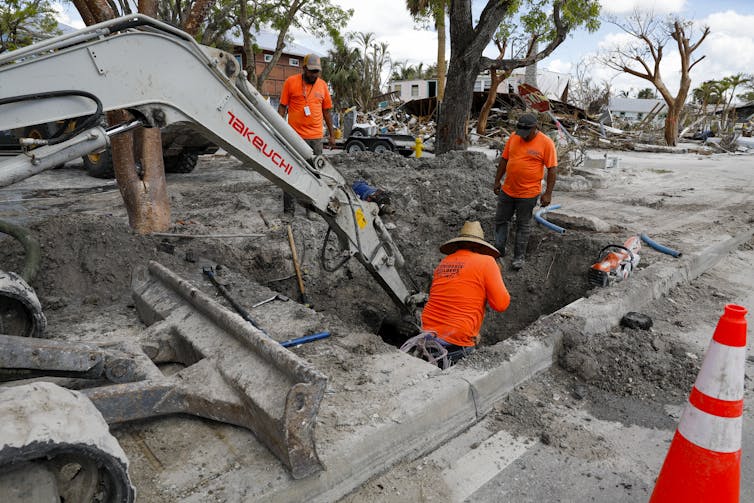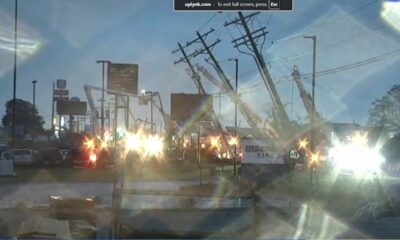Cassandra Burke Robertson, Case Western Reserve University and Irina D. Manta, Hofstra University
A sweeping crackdown on immigration was the centerpiece of Donald Trump’s 2024 presidential campaign.
“On day one, I will launch the largest deportation program of criminals in the history of America,” Trump promised at a rally in Madison Square Garden in late October 2024.
After winning, he suggested in a Nov. 18 post on his social media site Truth Social that he could use the U.S. military to achieve his goal by declaring a national emergency. At other times, Trump and his campaign officials have announced plans to activate the National Guard and local police forces to assist with immigration enforcement.
We are law professors who’ve studied the complex intersection of executive power and immigration enforcement. Our research suggests that Trump may have some legal authority to deploy armed forces to secure the border. However, both practical and constitutional hurdles will make it extremely challenging for him to follow through on his threat of mass deportations.
What the military can and can’t do
The legal requirements for getting the military involved in immigration enforcement are complicated.
No single law explicitly prevents Trump from using U.S. military assets for deportations. Different legal rules govern military forces, state defense forces and civilian law enforcement. That means legality depends on not just whether the military is used but also how.
First, Trump can likely seek the assistance of the National Guard, a unique military force with dual roles, to police the border. The National Guard is primarily a state-based military force under the control of the governors, but the president can also activate it for a federal mission.
As the Congressional Research Service, a government agency, explained in a 2023 report, there “is precedent for deploying National Guard units to the southwestern border to assist with immigration control.” Presidents Barack Obama and George W. Bush both dispatched National Guard troops to assist with security at the southern border.
Trump would be on weaker legal ground in using members of the regular armed forces to conduct direct deportation activities such as arresting and detaining people. The Posse Comitatus Act generally forbids using the federal military to enforce domestic laws.
But he may be able to use the military in a support role. Title 10 of the U.S. Code specifies that the military may “train and advise civilian law enforcement agencies” and provide other kinds of support. In practice, the military could probably give immigration officials and other law enforcement entities expert advice and training, and loan them equipment.
As for Trump’s proposal to enlist local law enforcement into immigration enforcement, that would depend on their voluntary cooperation.
A 1996 amendment to the Immigration and Nationality Act allows the federal government to deputize state and local law enforcement officers to perform certain immigration functions. However, law enforcement agencies cannot be compelled to participate.
So far, police in some counties in Maryland, North Carolina and a few other jurisdictions have indicated willingness to partner with federal authorities on immigration enforcement. Other police departments have already declared they would not cooperate on deportations, including Los Angeles, Boston and South Tucson.
A US$315 billion price tag
Any mass deportation effort would face enormous practical challenges. Trump has said that he would seek to deport “probably 15 million and maybe as many as 20 million” people.
The nonprofit American Immigration Council estimates that there are 13 million people in the U.S. without permanent legal status, and removing them all would cost at least $315 billion. The current budget of the U.S. Immigration and Customs Enforcement agency, or ICE, is about $8 billion.
Beyond the financial burden, mass deportations would significantly disrupt the U.S. economy, particularly the construction and agriculture sectors.
More than 20% of construction workers are undocumented, and the percentage is even higher in specialized roles such as drywall and ceiling tile installers, over one-third of whom are believed to be undocumented. In areas where construction workers are in high demand, such as California’s wildfire-damaged regions, the labor shortage created by deportations would hit particularly hard.
Agriculture would also face significant worker shortages: 40% of crop farmers lack work authorization, according to government estimates.
A crew works to restore electricity to Floridians after Hurricane Ian in 2022. Many laborers who rush in to help after a disaster are undocumented.
Legal battles ahead
Perhaps the most significant challenge to Trump’s immigration crackdown lies in ensuring protection of civil rights.
Trump has compared his deportation plans to President Dwight Eisenhower’s efforts in the 1950s – a historical parallel that raises serious concerns. During that 1953-54 campaign, the Border Patrol worked with local officials to send Mexican immigrants across the southern border. U.S. citizens were sometimes wrongfully deported.
Likewise, in mass deportation campaigns conducted during the Great Depression, an investigation by California state Sen. Joseph Dunn found that close to 60% of the people deported were actually American citizens born to immigrant families.
Today, too, immigration agents regularly detain and even deport U.S. citizens. Citizens account for approximately 1% of all immigration detainees, according to a study by a scholar at Northwestern University.
The Government Accountability Office reports that between 2015 and 2020, ICE locked up hundreds of U.S. citizens. At least 70 were deported – and likely many more whose citizenship went unconfirmed.
Historically, the Supreme Court has deemed this mistake unacceptable.
It would be better for many immigrants to be “improperly admitted,” the court wrote in 1920, than for even one citizen to be “permanently excluded from his country.”
The Supreme Court has never retreated from this position, and federal courts have historically intervened to block fast-track deportation efforts that lacked due process protections.
In 2019, during Trump’s first administration, U.S. District Judge Ketanji Brown Jackson – now a Supreme Court justice – issued a preliminary injunction halting expedited deportation procedures that failed to give individuals adequate legal safeguards. Following much legal wrangling, that case was ultimately dismissed after the Biden administration changed policies.
New cases will likely arise with Trump’s return. His proposed mass deportations are broader in scope than his previous efforts, and civil rights organizations are already preparing to legally challenge them.
“Trump’s threatened actions on immigration run counter to protections in the Constitution and statutes enacted by Congress,” reads the American Civil Liberties Union website. “And we will make him answer for his lawlessness in the courts.”
The key question here isn’t just whether Trump can legally deploy military assets to deport people. It’s whether such a massive program can be executed while respecting constitutional rights and maintaining economic stability.
Based on our research, the answer appears to be no. We expect legal turbulence from the very start of Trump’s second term.![]()
Cassandra Burke Robertson, Professor of Law and Director of the Center for Professional Ethics, Case Western Reserve University and Irina D. Manta, Professor of Law and Director of the Center for Intellectual Property Law, Hofstra University
This article is republished from The Conversation under a Creative Commons license. Read the original article.























































